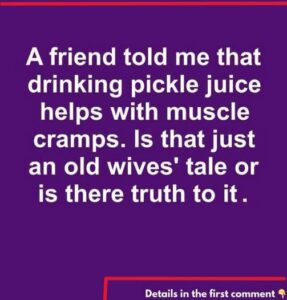Can Pickle Juice Really Stop Muscle Cramps, or Is It Just a Myth?

Anyone who has ever shot upright in bed from a sudden calf cramp—or had their workout cut short by a spasming muscle—knows how badly you want instant relief. Cramps are extremely common, and they can be triggered by many things: dehydration, pushing your muscles too hard, nerve irritation, fatigue, or an imbalance of electrolytes such as sodium, potassium, magnesium, and calcium. Usual fixes include stretching, massages, bananas, or sports drinks. But in recent years, a strange contender has taken center stage among athletes and fitness lovers: pickle juice. The question is—does it actually work, or is it just another internet fad?
Why Pickle Juice Might Work
At first glance, pickle brine doesn’t sound like a miracle cure—it’s mostly water, vinegar, salt, and spices. Many assumed its benefit came from replenishing electrolytes, similar to Gatorade. But studies have revealed something surprising: the relief happens far too quickly for electrolytes to be the explanation. Athletes often report cramps easing in as little as 30–90 seconds—not nearly enough time for minerals to enter the bloodstream.
So what’s really going on? Researchers believe the secret lies in the vinegar’s acidity. The strong, sour flavor stimulates receptors in the mouth and throat, which then send signals through the nervous system. Those signals seem to override the faulty nerve messages that trigger the cramp. In other words, pickle juice doesn’t fix the underlying cause—it just “resets” the nerves long enough for the spasm to release.
How to Use It
If you want to test it out, the method is straightforward: at the very first twitch of a cramp, sip 2–3 ounces of pickle juice (yes, straight from the jar). For many, relief comes within a minute or two. The flavor is strong—salty, sour, and intense—but if it ends the pain, most agree it’s worth the puckered face.
That said, don’t overdo it. Pickle juice is very high in sodium, so it’s not wise for anyone with high blood pressure, kidney problems, or who’s on a low-salt diet. Think of it as an emergency trick, not a daily beverage.
Who Benefits Most
Pickle juice seems particularly useful for athletes dealing with cramps during long runs, bike rides, or heavy training sessions. It may also help older adults who regularly suffer from nighttime leg cramps. For people who tend to have low sodium levels, the salty brine might give an extra boost.
However, it’s not for everyone. Those with acid reflux often find vinegar makes their symptoms worse, so caution is advised.
Other Remedies Worth Trying
Even though pickle juice works for many, prevention is always better than scrambling for a quick fix. To keep cramps at bay:
-
Stay hydrated throughout the day.
-
Eat potassium-rich foods like bananas, spinach, and sweet potatoes.
-
Boost magnesium intake from nuts, seeds, and whole grains.
-
Stretch regularly, especially after workouts or before bed.
-
Some find relief from tonic water with quinine or magnesium supplements.
The Bottom Line
Pickle juice won’t cure the root cause of muscle cramps or replace lost electrolytes, but research shows it can offer fast, temporary relief by short-circuiting the nerve signals behind the spasm. For athletes, fitness buffs, or anyone who dreads sudden nighttime cramps, it’s an inexpensive and surprisingly effective trick to keep on hand. Just remember—real prevention still comes down to hydration, nutrition, and muscle care.